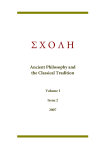Schole. Философское антиковедение и классическая традиция @classics-nsu-schole
Статьи журнала - Schole. Философское антиковедение и классическая традиция
Все статьи: 733
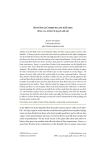
How Souls Communicate in Hades (Proclus, In Rep. II.163.18-168.26)
Статья научная
In the Myth of Er in the Republic Plato describes various aspects of the soul’s afterlife. At 614e3-615a4 he writes that souls who have gathered on the plain of judgment are then divided into those who lived morally good lives and so rise into a place of reward and those who have not who descend into the realm of punishment. On the souls’ return to the plain after their time above or below, they greet one another and tell each other of their experiences. Some 700 years later, Proclus in his commentary on the Republic tries to answer some issues that this short passage must have raised for some philosophers in antiquity. The problem is simple enough: how can souls who do not have bodies or organs of sense communicate in this way? Proclus lays out his response in several stages. He agrees, of course, that souls in the underworld do not have corporeal bodies. However, they do have ethereal vehicles, and these vehicles, he says, are more closely adapted to the souls and therefore less likely to introduce errors in the souls. Thus, the seeing and hearing in Hades is actually clearer and more directly known than those that occur when we are imprisoned in our bodies. These vehicles retain the images received when we were embodied, and thus we can recognize other souls and communicate with them. As for hearing and speaking, the vehicles are actually better at these tasks than the organs in our bodies. How Proclus reaches these conclusions is not immediately clear from the Republic commentary, but with the aid of other works, especially the Timaeus commentary, we will be able to see how Proclus attempts to make the case for disembodied souls speaking and hearing in the underworld.
Бесплатно
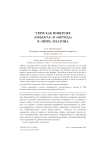
Hybris как инверсия «объекта» и «метода» в «Пире» Платона
Статья научная
Задача работы - показать, что одним из лейтмотивов «Пира» является семантика гюбриса как «инверсии», которая относится к теме взаимодействия противоположностей, обыгрываемой на протяжении всего диалога на уровне лексики, поведения персонажей, собственно философского содержания и самой композиции диалога. Как инструмент анализа этих уровней текста используются ключевые метафоры инверсии и гюбриса в «Пире» - андрогины из речи Аристофана и силены из речи Алкивиада. Делается вывод, что в целом «Пир» можно назвать апологией философского гюбриса как инверсии «объекта» и «метода» в форме своеобразной «сатировой драмы».
Бесплатно

Iamblichus path to the ineffable
Статья научная
Iamblichus of Chalcis postulated theurgy on metaphysical grounds as the only means of communion with the supreme principle of everything that exists. Iamblichus sets this principle as a completely transcendent reality, unattainable by reason, and, at the same time, differs from Plotinus, who postulated absolute withdrawal from everything and conceived union with the One as an escape in solitude to the solitary. Iamblichus conceives matter as an instrument for the souls ascent to that principle and explicitly proposes a mysticism of solidarity with the cosmos and with other souls.
Бесплатно
Iconography of Plato in antiquity and in medieval orthodox painting
Статья научная
The article is devoted to the topic of visualization, which is relevant for the modern world in general and scientific knowledge in particular, investigated through the image of Plato in Antiquity and in medieval Orthodox painting. Using the example of Plato’s iconography as a visual message, the authors want to show the great potential for the development of the visual history of philosophy, anthropology and culture in general, as well as the new visually oriented semiotics and semantics of the image. This approach reveals expressively and meaningfully its relevance for the study of Plato’s image, together with other ancient philosophers’ images, in Orthodox medieval churches in Greece, Serbia, Romania, Bulgaria and, of course, ancient Russia in the 15th-17th cc, allowing to see the great ancient Greek philosopher from a new perspective.
Бесплатно
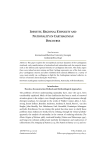
Identity, regional ethnicity and nationality in Carthaginian discourse
Статья научная
This paper explores the sociopolitical and state dynamics of the Carthaginian statehood, early manifestations of nationhood and nationalism and also unpacks issues such as the identity and regional ethnicity in Carthaginian discourse. This study argues there were indeed ancient nations and that Carthage represents one of the best examples. Carthaginian citizens and allies exhibited their national affiliation in a variety of ways, most notably via a willingness to fight for the Carthaginian national collective in the face of extreme duress during the Punic Wars.
Бесплатно
Статья научная
A Persian-Early Hellenistic glass intaglio with the portrait of Silenus was found in Galilee some years ago. Except for the testimony of the spread of Dionysiac cults in the Syro-Palaestinian region during such an early period, the occasional finding would not bear so much meaning if not for the unique iconographical features of the Silenus’s portrait. When turned upside down, the face of the apathetic, passionless Silenus transforms into the portrait of the evil face, supposedly of a Cyclop Polythemus or satyr's mask (two interchangeable faces). The composition of the “inverted faces” might be considered one of the types of more developed synthetic compositions comprised of several faces or creatures and usually applied on the gems (known as janiform or grylloi/baskania). Many remote parallels were mentioned in these rows of examples. The “inverted faces” (bes or pazuzu) are rarer, but they were still applied to some Persian and Hellenistic coins and gems, which were often interconnected iconographically. Most notable is the Roman red glass gem in the British Museum collection, which is decorated with two “inverted faces”: it is incredibly close by its iconography to the gem under consideration. In addition, a unique Roman ceramic beaker from the Budapest History Museum and the Roman glass flask from the Eretz Israel Museum in Tel Aviv adorned with interchangeable faces were mentioned and interpreted. In my opinion, the composition with “inverted/summary faces” is highly underestimated in the history of Classical art and might be detected in a broader range of samples if only it was taken into consideration (usually, the reversibility of the faces remains unnoticed).
Бесплатно

Intimations of Socratic Philosophy. Exploring the Apocryphal Dialogue: On Justice
Статья научная
This essay providers an analysis of the apocryphal “Platonic” dialogue On Justice and develops a unique notion of Socratic philosophy that is present within this ancient example of Sokratikoi Logoi but requires elucidation. It unfolds in three main sections focused on: (1) Dialectic as an example of a “speech-act,” where the use of words “commits” Socrates and his interlocutors to the task of developing an ethical soul in and through reasoned discourse; (2) Socrates’ embrace of a form of ethics termed “practical-and-contextual ethics, as related to eudaimonic ethics, which reveals that unlike “action-based” ethics, Socratic ethics is concerned with ethical behavior within specific and unique contexts and situations, indeed, in great part, the many situations within Socrates finds himself actually guide and direct his ethical behavior - the deliberation concerning the virtuous choices made at the appropriate or right time; and (3) The question concerning how ignorance is related to the ethical choices made in praxis, and it is argued that following Socrates, ethical decisions are indeed possible despite lacking a full and complete knowledge of virtue or the virtues such as courage, temperance, piety, wisdom, or as related to the apocryphal dialogue, “justice.” Ultimately, the analysis seeks to offer the reader an intimation of what an authentic notion of Socratic philosophy might look like despite the Platonic inauthenticity of the source material.
Бесплатно
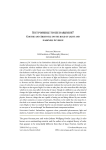
Is it possible to see darkness? Goethe and Aristotle on the role of light and darkness in vision
Статья научная
J.W. Goethe in his Farbenlehre deduced all physical colors from a simple primordial phenomenon that takes place every time light and darkness act through a semi-transparent colorless medium either on our eyes or on the opposite surfaces. This basic rule of Goethe’s color theory was criticized by his contemporary physicists, who argued that darkness could not play an active role in the origin of colors because of being a mere absence of light. The paper demonstrates that this criticism became possible only if one shares the Newtonian view on the nature of light and darkness. Goethe however held a more traditional point of view, which he traced back to Antiquity and Aristotle. In contrast to Newton and his followers, previous scientists considered light not as an immediate cause of colors but as an actually transparent medium that conveyed colors from the visible objects to the organ of sight. For vision to take place, the color must first affect the light, which in its turn, must affect the faculty of vision. Though it is difficult to say what kind of change the light undergoes when some colored object is seen through it, most Aristotle commentators agree that this change must be real and not mere relational. In Aristotle’s physics, however, things that are capable of acting on and being affected by one another are either contraries or consist of contraries. Therefore, to be visible the color must be either dark or to contain darkness. Thus, assuming that Goethe shared the Aristotelian concept of light, we have to conclude that he was not mistaken saying that darkness "acts” upon our eyes or “is seen through” the illuminated semi-transparent medium.
Бесплатно
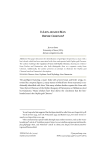
Is lion-headed man orphic Chronos?
Статья научная
This paper discusses the identification of god figure depicted as a man with a lion's head, which has been associated with Aion and equated with Orphic god Chronos. The author challenges the equation of Aion with Orphic Chronos, drawing on evidence from Proclus and Damascius, who both distinguish Aion as a separate entity from Chronos. Additionally, the author presents an attempt to illustrate the Orphic god Chronos based on Damascius' description.
Бесплатно
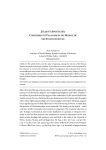
Julian’s Apostates: conversion to paganism in the middle of the fourth century
Статья научная
The article delves into the issue of apostasy among the citizens of the Roman Empire during the brief reign of Julian. It provides an overview of the tactics employed by the emperor to convert his Christian subjects to paganism and evaluates their success across different strata of late Roman society, including the bureaucracy, military, Christian clergy, intellectual elite, and common people. It is concluded that Julian’s efforts at returning the Roman Empire to paganism were far more successful than it has traditionally been thought.
Бесплатно
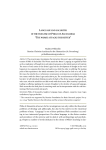
Language and laughter in the treatise of Philo of Alexandria “The Worse attacks the Better”
Статья научная
The present paper investigates the interaction between Logos and language in the treatise of Philo of Alexandria "The Worse attacks the Better". Language is regarded by Philo as the actualization of thought in its articulated expression, as the initial moment of creativity. The source of such action is the divine Logos, but the development of thought in the word happens in two opposite directions: one leads to joy, while the other, to suffering. The starting point of this separation is the initial orientation (love) of the mind to God or to self. In the first case, the mind in the act of utterance (expression) overcomes its own isolation. It comes into contact with the divine Logos and achieves joy. The crucial moment of this "leaving the brackets" of self individual thinking towards the light of the divine Logos is laughter. In another case, when the mind does not link words with their source, false creativity is produced, leading to suffering. Аpplying the concept of laughter to the doctrine of Logos and language, Philo reconciles the ideal plan of conceiving truth and its interpretation with the real functioning of the human mind and speech.
Бесплатно
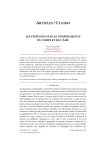
Les sto"iciens sur les temp'eraments du corps et de l’^ame
Статья научная
This article is concerned with the often neglected physical side of Stoic anthropology. The care for one’s soul is central to the Stoic notion of the art of living. Yet a special status is reserved for the human body—in spite of its being subsumed under the class of (preferred) ‘indifferents’. This status is explicable by reference to the fact that they regard the soul as a subtle kind of breath ( pneuma ) and hence as corporeal. As such, it is blended with the human body through and through. Care for the soul therefore involves care for the body. Furthermore, the Stoic view of the human organism entails a special interest in physiognomy. These interrelated aspects are studied against the backdrop of the relevant medical theories used by the Stoics.
Бесплатно
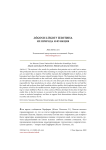
Logos и logoi у плотина: их природа и функция
Статья научная
Космос возникает не в результате деятельности творца, но согласно природе. Это возникновение не предполагает мышления или концептуализации, но является результатом действия силы, которая запечатлевает себя в материи. Ум сообщает умопостигаемые формы, которые в нем содержатся, гипостазированной Душе, в которой они превращаются в рациональные формулы (logoi). Затем Душа передает эти рациональные формулы мировой душе, которая порождает одушевленные и неодушевленные сущности, словно по указанию, полученному свыше. Однако, поскольку за порождение ответственна низшая часть мировой души, которая действует по своему разумению, возникшие в результате сущности уступают по качеству своему образцу, что объясняет несовершенство чувственно воспринимаемого космоса и наличие зла, несмотря на присутствующую в нем направляющую силу Промысла.
Бесплатно
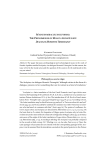
Magnum miraculum est homo. The phenomenon of man in asclepius sive dialogus hermetis trismegisti
Статья научная
The paper discusses anthropological and eschatological issues in the work of Pseudo-Apuleius entitled Asclepius, sive dialogus Hermetis Trismegisti. In this context, the issue of evil in the moral sense and the question of the sources of evil understood in this way are raised
Бесплатно
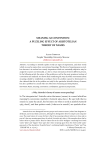
Meaning as convention: a puzzling effect of Aristotelian theory of names
Статья научная
According to Aristotle spoken words are signs of impressions, and those words which are used as names have conventional meanings. This theory of meaning poses a problem because it is unclear how exactly impressions which are essentially subjective may be assigned to names conventionally, i.e. due to certain interactions between different persons. In the following article the nature of the problem as well as the most prominent notions of conventions are analyzed: it is shown that considering the ways by which conventions about meanings should be established according to them the problem cannot be eliminated. It is also claimed that this is the problem not only for the particular Aristotle's theory of names, but also a problem for a much wider set of theories of meaning and interpretation.
Бесплатно
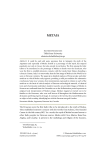
Статья научная
It could be said with some precision, that in Antiquity the myth of the Argonauts and especially of Medea herself as a personage of this myth, has enjoyed popularity not only in Greece but also outside its territories. The first among the Italic tribes to be introduced to the personage of Medea no doubt were the Etruscans, who were the first to establish intensive contacts with the Greeks from Euboea founding a colony in Cumae, Italy. It is noteworthy that the first image of Medea in the World Art is seen on Etruscan ceramics. The paper gives detailed analyses of Etruscan olpe and other artefacts on which Medea early appears, providing a solid precondition for substantive conclusions. Some new versions of an interpretation expressed in relation to each of the artefacts on the basis of critical analysis of Etruscan archeological material, of classical texts and of previously undertaken modern research, are provided. Images of Medea in Etruscan art confirmed from the Orientalist era to the Hellenization period represent an original, local interpretation of Medea's image. Medea's magical art turned out to be familiar to the Etruscans, who were well known all throughout the Mediterranean for divination and being experts of magic. In contrast to the Greeks, they turned Medea into an object of cult worship, identifying her with the Etruscan sun god Cavatha.
Бесплатно
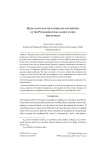
Modulation and the underlying assumptions of the pythagorean ban against eating broad beans
Статья научная
This paper tries to show that the theory of mental models describes deep mental processes that have to be assumed even by frameworks contrary to it. It has been argued that many explanations on certain cognitive activities different from that provided by the theory of mental models cannot ignore theses of this last approach. Those theses are related to the way the human mind interprets linguistic information and makes inferences. The main goal here is to give further evidence in this way by means of an analysis of a part of a fragment, authored by Diogenes Laërtius, about the Pythagorean ban against eating broad beans. The idea is to make it even more evident that any framework trying to account for how that part of the fragment can be understood by a reader needs to accept suppositions that characterize the theory of mental models.
Бесплатно
Статья научная
We know that Modus Tollendo Tollens is a difficult rule to apply. We also know that there are circumstances in which people easily use it. One of those circumstances is whenever the conditional premise is an obligation conditional. On the other hand, the Stoic criterion of the conditional, that is, the proposal Chrysippus of Soli gave for the latter logical connective, has been related to Non-Axiomatic Logic and Inheritance Logic. My aim here is to try to show that obligation conditionals can be deemed as deontic inheritance statements in Non-Axiomatic Logic or Inheritance Logic. I will attempt to argue that it is possible to build a deontic inheritance logic with two essential characteristics. First, it respects the Stoic criterion of the conditional. Second, in consistence with the literature, it leads to the conclusion expected by classical logic when the conditional is an obligation.
Бесплатно


